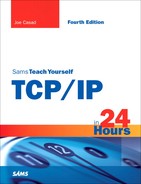Email Format
Your email reader application assembles a message into the format necessary for Internet transmission. An email message sent over the Internet consists of two parts: the header and the body.
Like the body of the message, the header is transmitted as ASCII-based text. The header consists of a series of keyword field names followed by one or more commaseparated values. Most of the mail header fields are familiar to anyone who has worked with email. Some of the important header fields are given in Table 18.1.
Following the header is a blank line, and following the blank line is the body of the message (the actual text of the electronic letter).
Users often want to send more than just text with an email message. A number of methods have emerged for transmitting binary files through email. Early strategies involved converting the binary bits into some ASCII equivalent. The resulting file looks like ASCII text—in fact, it is ASCII text—but you can’t read it because it is just a jumble of letters representing the original binary code. The BinHex utility (originally developed for the Macintosh) and the Uuencode utility (originally developed for Unix) use this method. You or your email reader must have the necessary decoding utility to convert the file back to its binary form.
A more general and universal solution for sending binary files through email has emerged through the MIME format. MIME is a general format for extending the capabilities of Internet email. A MIME-enabled email application encodes the binary attachment into MIME format before transmission. When the message is downloaded to the recipient, a MIME-enabled email application on the recipient’s computer decodes the attachment and restores it to its original form.
MIME brings several innovations to Internet mail, including the following:
Expanded character sets. MIME is not limited to the standard 128-character ASCII set. This means you can use it to transmit special characters and characters that aren’t present in American English.
Unlimited line length and message length.
Standard encoding for attachments.
Provisions for integrating images, sound, links, and formatted text with the message.
Most email reader applications support MIME. MIME format is described in several RFCs.
